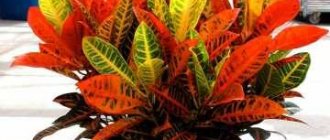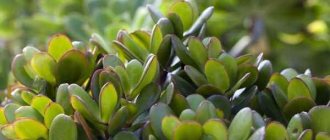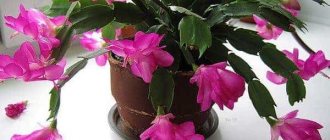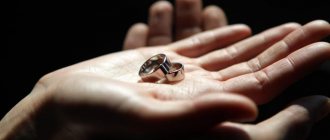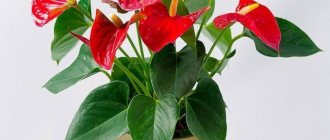The ancient Slavs had many beautiful legends, and a huge number have survived to this day. In one of the most popular, the central figure is a fern flower. Many people dream of finding it and plucking it, because it is believed that it can work miracles.
The legend of the fern flower (Perun's color). What does a flower look like
Perunov's color Since ancient times, the fern flower amulet has been considered a fiery symbol and carries within itself the energy of genuine purity and nobility.
The second name of this amulet is Perun’s color. It is also called Heat-color and Shine-color. According to legend, Perunov's color is a unique flower that can only be seen on the night of Ivan Kupala. A person who sees such a plant will receive unusual skills to see the properties of his soul, and will also be able to fulfill his most cherished desires.
In addition, Perun’s color will allow the person who finds it to have the opportunity to maximize their hidden inner potential. According to beliefs, the god Perun presented a gift in the form of the Perun color symbol to the heirs of Semargl, who protected the Palace of the Sun.
But at one moment Perun’s brother fell in love with the Goddess of the summer night, whose name was Bathing Suit. They could not be together, but their union was nevertheless realized, and they had two children. It was on this occasion that Perun presented his brother Semargl with a symbol that was elegant and fulfilled all the desires that seemed impossible to everyone around.
The appearance of the sign has a bright solar structure, symbolizing the sun or Its movement. All signs that look like this reflect the movement of galaxies in the Universe. The basis of the sign is made up of four main rays emanating from the center of the symbol, from which, in turn, small rays extend. The design of the symbol is such that the rays can be constantly drawn, thereby continuing the symbol ad infinitum.
General information
These plants have been on earth for almost half a billion years, three times older than the flowering plants that are currently the dominant type of flora. However, having stood the test of evolution and time, ferns are now very successful and occupy their niches in the ecological chains of the planet. Flower growers did not ignore them, although formally ferns, of course, do not have flowers, but reproduce in completely different ways.
An overgrown specimen of nephrolepis fern
These plants exist on all continents of our planet. The number of their genera alone exceeds several hundred, and the species - about ten thousand. For the most part, these are low-growing plants that love partial shade and high humidity. Although, sometimes giant tree ferns are also found.
All ferns contain in their shoots a small amount of toxins that perform a protective function. This poison does not pose a danger to humans because, firstly, it is not released into the air, and secondly, its concentration is too low. However, crushed shoots of many species (for example, bracken or shieldweed) are used as anthelmintics.
One of the features of ferns is the interesting shape of their “leaves,” called “fronds” by biologists. They are a leaf-like organ that actually grows like a shoot. As it grows, lateral shoots, mistakenly called leaves, immediately form on it. The length of the frond and the number of branches on it can be very diverse. Young fronds are tiny shoots twisted into a spiral.
Growing fronds of ostrich fern
The structure of fern roots also has a number of features. The root system consists of one large root, from which many small ones branch. Some of them are covered with peculiar scales. They represent those fronds that did not grow outward, but remained underground.
Dallalia fern roots
In the lower part of the surface of the frond there are sporangia - the reproductive organs of the fern, containing many spores.
Sporangia of Nephrolepis fern
From the spores, the so-called gametophyte is formed - a multicellular structure in which sex cells are formed and fertilization occurs. After which, the growth of the sporophyte begins - the plant that will produce spores. In fact, all growing ferns are sporophytes ; It is very difficult to notice gametophytes emerging from spores.
The time during which the gametophyte will be formed is quite long; moreover, it varies significantly among the same species. Therefore, propagating ferns using spores at home is quite problematic.
Gametophyte or prothallus of the nephrolepis fern; size 3-4 mm.
Preference is given to vegetative propagation. Like many flowering plants, propagation of ferns is carried out by dividing the bush, cuttings, shoots, and so on. But, as practice shows, it is the first one that is the most successful and reliable.
Floristry distinguishes three varieties of these plants:
- Home or indoor
- Garden
- Water
House ferns are grown indoors because they require quite specific conditions. First of all, this relates to the requirements for temperature and air humidity. Most of them represent plants originating from tropical or subtropical climates.
As a rule, they are shade-loving and prefer moist air . These plants require constant irrigation of their foliage, which gives them the illusion of tropical rains. They are unpretentious in care, but are sometimes susceptible to attacks by pests (mainly insects) and like frequent feeding.
Ferns are best fertilized using specialized fertilizers designed specifically for them. If this is not possible, you must use any fertilizer for flowers; however, a normal concentration for ferns would be about half that needed for, for example, orchids or violets.
Fern "Boston Fern", a typical representative of indoor plants
Garden ferns contain approximately 200 species, a quarter of which are frost-resistant and can be grown in our latitudes in open ground. They are more hardy and resistant to diseases and pests, in addition, such plants practically do not need fertilizing. Their sizes can be quite large: bushes can reach up to 1.5 m in height and up to 1 m in diameter. They have a developed root system, and their growth rate is such that caring for them consists of curbing their growth.
Garden fern adiantum
Aquatic ferns, as their name suggests, prefer to grow in water; These can be either small standing bodies of water, streams or small rivers. Such ferns have a poorly developed root system, and their fronds most often have a feathery structure. They have a fairly large stem, most often spreading along the surface of the water, from which numerous fronds grow.
Azolla water fern
In indoor floriculture, mainly domestic varieties are used. Growing garden or water ferns indoors is quite problematic: the former require truly gigantic pots to accommodate the root system, while the latter require the use of fairly large containers of water to create conditions similar to their natural habitat.
The meaning and properties of the Slavic symbol:
For men.
Since Perun’s color is a talisman from Perun, the Slavic god of thunder and justice, this symbol is ideal for men. Perun, first of all, personifies strength and courage. For this reason, this amulet was very often used by warriors who believed that the amulet gave them dexterity, determination, and courage in battles. Also, the amulet was passed from father to son, and with each generation the amulet acquired great unknown power.
For women
Since Perunov's color is a universal amulet, it is also suitable for women. The amulet helps the woman wearing it to keep the hearth, gives happiness, peace of mind and helps to find her purpose in life.
Literature
- Sakharov I.P.
Tales of the Russian people. People's diary. Holidays and customs. - St. Petersburg: Moscow State University Publishing House, 1885. - 245 p. - Tereshchenko A.V.
Life of the Russian people: fun, games, round dances. - M.: Russian Book, 1999. - 336 p. — ISBN 5-268-01383-1. (according to the edition of 1847-1848). - Razzakov, Fedor Ibatovich.
The Legend of the Red Rue: excerpt // Sofia Rotaru and her millions [Text]: biogr. / F. I. Razzakov. - M.: Algorithm, 2012. - 379, [4] p., [8] l. ill. : portrait - (Legends of the author's song). — ISBN 978-5-4438-0159-9. - Chervona Ruta [Electronic resource]: [arch. November 28, 2017]: p. blog // User's journal holonist: blog. - Holon, Israel: LiveJournal, 2021. - September 5.
The difference between Perunov's color and overpowering grass
There is another color amulet similar to Perun’s – Overcome grass. Very often these two symbols are confused, since one symbol is a mirror image of the other, but their meaning and significance are somewhat different. Thus, the sign of Perun is primarily aimed at developing spiritual internal qualities, and Odolen grass forms protection against bodily diseases and strengthens physical health. In all other respects, both symbols have similar meanings.
Is it possible to make a talisman yourself and how?
Most often, Perun's color was used as body decoration (for example, various amulets made of wood and metal). But there are also other ways to use the symbol. Thus, the amulet was applied in the form of an ornament on dishes, embroidered on towels and clothes, and amulets were made from fern leaves. Today, rings and pendants with engravings in the form of Perunov’s amulet are often found. Dry fern leaves were often used as an amulet to protect the house.
They were placed in a vase as home decoration. It also happened that the leaves were placed on hot coals in the oven. So, according to legend, at this time the house was cleansed of damage and bad energy. The amulet was embroidered on clothes following strict rules. The amulet was applied only on the night of the waxing moon, and at the same time the central elements of the symbol were precisely positioned. There are a number of rules that must be used when embroidering a talisman:
- A boy or girl should be in a good mood and embroider the amulet only according to his sincere desire;
- When embroidering, you need to think about who this amulet will be intended for;
- The symbol will have greater power if it is sewn by a blood relative;
- Cotton threads are used to embroider the amulet;
- The embroidery of the ornament should not have knots;
- The correct colors were used for embroidery: purple (for aggression) and green (for prosperity)
Also, it is worth noting that to enhance the effect of the amulet, its embroidery on clothing was often combined with other amulets.
Fern blossom
In reality, a fern never blooms - it reproduces by spores.
A. B. Strakhov compared the beliefs about the fern flower with European folk legends about the flowering and fruiting of trees on Christmas night. He came to the conclusion that all such ideas do not have any “pagan” background and represent a popular reinterpretation of the biblical comparison of the Mother of God (who conceived and gave birth, remaining a virgin) with the blossoming rod of Aaron[6].
- Stamp of Ukraine with the legendary fern flower. 1997
- Blooming Aaron's rod. German miniature, XV century.
- A “fertile leaf” that looks like a fern flower, but is not one.
Fern symbol tattoo
Photo of a tattoo
Another popular way to create a talisman is to apply a symbol to a person’s skin in the form of a tattoo.
The image can be either the symbol itself or fern leaves.
One of the main conditions is that the place for such a tattoo should be that part of the body that is least accessible to prying eyes.
A tattoo with Perun's amulet allows you to reveal the owner's abilities, ensure spiritual balance, and protect against the evil eye and damage.
Description of the plant
Fern is a herbaceous plant belonging to the Osmundaceae family, genus Fernaceae. The homeland of the plant is Northern China, Korea, and the Far Eastern Russian region. Distributed in Russia, Ukraine, Finland, and Central Asia. It is a green stem with numerous feathery dissected leaves. The fern reproduces only through spores and does not bloom.
Interesting. Ferns are considered one of the most ancient plants on the planet, which appeared in the Devonian period of the Paleozoic era. The wood of the plant later became a source of coal.
It is believed that this plant is a descendant of the first plants on the planet - rhinophytes. Their branches gradually turned into leaves, and the spores moved from the end of the branches to the underside of the leaf. The process of spore emergence and maturation is very similar to flower growth. The plant is collected all summer.
Today there are thousands of species of ferns.
Fern structure, flowering
The fern trunk is smooth and has no scales. The root system is powerful. The root is a creeping root; buds are formed on it, from which young shoots are formed. Stepchildren appear from the ground at a distance of 10 to 20 cm. Initially, they have a snail-like head, which gradually turns into leaves.
Sporulation is the main method of fern propagation. The spores grow on the back of the leaf. As the spore capsule matures, it cracks and the spores scatter in the wind. As soon as they fall on favorable fertile soil, they begin to grow.
During the growth of the spore, a prothallus is formed in the form of a small green cup. Sperm and eggs appear on the reverse side of the growth. After fertilization of the egg, germination of the seed begins, and the stepson begins to take root. The fern forms a bush over several years. Fern blossoms are impossible.
Vegetative propagation of fern is possible. At the same time, long arrows are formed on the bush. They bend down to the kidney and are pressed down by the stone. Such reproduction is also carried out by humans in a garden or summer cottage. The arrow takes root in the ground. For replanting, a fragment of earth is dug up along with the root system.
Ferns also reproduce by division. In early spring it must be removed from the ground. Dense roots are washed from the ground with water, divided into shoots, which are then transplanted to another area.
What is called leaves in everyday use is called fronds in science. They are able to grow in length for a long time. Fronds take an active part in photosynthesis and plant reproduction.
The bark of the stems acts as a support. Ferns do not have a cambium, so they are fragile. Compared to angiosperms, they have much weaker conducting tissues.
The structure of the fern is very different, depending on the species. There are low herbaceous plants, and there are also large ferns that resemble trees. Some ferns reach a height of 20 m. Moreover, the tree trunk forms branched and fairly strong adventitious roots.
Large ferns that resemble trees.
How to clean and charge the amulet?
After the amulet is made, it still needs to be properly cleaned and charged. This is done so that the amulet can retain its magical properties for a longer time. This stage is carried out with the help of natural elements: fire, earth, air, water.
Fire
In order to cleanse and charge the amulet using fire, you need to light a fire and place the amulet over it. After this, the amulet is removed from prying eyes in a dark place for a day.
Water
Charging the amulet with water
Here I use water with a large current (rivers, large streams, etc.).
According to legends, the current takes with it all the negative energy, leaving only good.
Earth
A hole is dug in the ground, into which the amulet is placed for a day or night. After the time has passed, the amulet is taken out and carefully wiped off any remaining soil.
Why does this representative of the flora have such fame?
Since time immemorial, people have endowed ferns with magical properties. It was used for witchcraft rituals and the treatment of serious ailments:
- He helped predict the future, open locks and constipations, and find treasures buried in the ground.
- To bewitch their lover, girls wove fern branches into their braids.
- The root was used to make amulets that protected against the evil eye, spells and love spells, and protection against diseases.
- A fresh fern rhizome, placed above the entrance to the home, protected the house from evil people and sorcerers.
- The plant helped maintain clarity of thought and prevented the gypsies from deceiving when communicating.
The witches collected tear-grass in the swamp or on the shores of reservoirs where turtles live. They fenced off the eggs with iron nails. According to legend, in order to free her offspring, the turtle always brought a magic plant.
Everything inaccessible and inexplicable is shrouded in mystery. This is why different peoples have so many legends and fairy tales related to ferns . Many consider it a favorite plant of sorcerers and evil spirits. To this day, there is a tradition of beating the fern crosswise and sprinkling holy water on the place where it grew.

